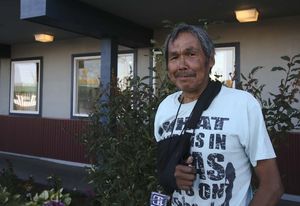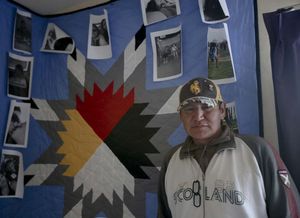ANCHORAGE — Scores of semi trucks rumble past on Fifth and Sixth avenues. Overhead is a near-constant buzz of airplanes that take off and land at nearby Merrill Field. Across the street are neon signs for check cashing, a fried chicken restaurant, a bar and luxury auto dealers.
Inside a tall black fence on a hot August morning, residents of Karluk Manor sat among vibrant patio flowers. Some slowly strolled the grounds using canes, walkers or wheelchairs, others sat in the smoking area. If they wanted, residents could retreat to the privacy of their room to drink.
Formerly a motel, Karluk Manor is Alaska’s original Housing First facility.
The concept behind Housing First is just that: Get homeless people off the street, as soon as possible. When provided a safe and stable residence, homeless people are better enabled to address health concerns and, it’s hoped, reduce their dependence on expensive health and social services.
Karluk, and a newer Housing First facility in South Fairbanks, use a harm-reduction model as opposed to requiring alcohol abstinence. In the harm-reduction model, alcoholics can still drink, but the hope is that they will drink less often. Medications, and some tenants’ financial resources, are held by staff members.
Nancy Burke, a senior program officer at the Alaska Mental Health Trust Authority, said the abstinence model has been prominent for “100 years or more” but doesn’t always work. She said traditional treatment providers occasionally view harm-reduction as a criticism of their work, to which she counters, “It’s complementing their work — picking up people who don’t make it.”
Colleen Ackerman, Karluk Manor’s program manager, compares the harm-reduction model to offering needle exchanges for intravenous drug users.
The 46 efficiency apartments at Karluk are offered to homeless people who have traditionally been the biggest users of social and health services. Applicants are rated on a point system. People who have been homeless the longest, have the lengthiest criminal histories or most emergency room visits go to the top of the list. Veterans get additional points.
Ed Quiver is one of those veterans. While in the Army Reserves he spent almost a year stationed in Iraq. Wearing dog tags around his neck and a baseball cap representing his home state’s University of Wyoming Cowboys, the 49-year-old Arapaho Indian spoke softly about fishing, rodeos and the initial shock of having somewhere safe to sleep.
“When I first came in, I sat down, the TV was the only thing here. I just sat down awhile.”
Not used to beds, Quiver slept on the floor for “quite awhile” after arriving.
Why housing?
It may sound backward giving subsidized housing preferences to people with more run-ins with the law, but the goal of Housing First isn’t necessarily to cure alcoholics of their disease.
If a safe and stable place to sleep reduces, for example, a persons emergency room visits, while providing an opportunity to turn their life around, many people consider that a success.
Another goal of Housing First’s harm-reduction is to minimize potential dangers. For drinkers, that may mean getting someone who usually consumes mouthwash to start drinking whiskey, then beer or wine. Burke said harm-reduction and abstinence models have their respective places.
“You really need a continuum in your community. You need housing that supports people with sobriety and continuing addiction. … Some people still have things to lose, and you want to get them in abstinence-based services. Other people have lost everything and are consumed by their addiction, and we need a different approach,” Burke said.
Cost, concerns:
Since opening in 2011, 88 residents have stayed at Karluk Manor and have had an average length of stay of slightly more than two years. About 75 people are on the wait list, enough to fill almost two similar facilities.
It costs $774 per month to house each resident. Tenants pay rent on a sliding scale. The minimum contribution is $50 per month and the average is about $250, according to Ackerman. A significant portion of remaining funds comes from a special needs housing grant from the Alaska Housing Finance Corp.
Ackerman acknowledges things don’t always run smoothly. Shortly after opening, the number of allowable visitors at any one time had to be restricted to 10 for the entire facility.
Twelve people have died at Karluk, both from alcohol-related illnesses and natural causes. Eight tenants have been evicted for violent behavior, an additional five for being unable to follow rules.
Ackerman said Karluk doesn’t have a party atmosphere, but drinking does ramp up “when money flows.”
Residents and businesses of Fairview, the Anchorage community in which Karluk sits, have their concerns.
Christopher Constant, president of the Fairview Community Council, said the community objects to the over-saturation of social services available in the area — a day shelter and soup kitchen, homeless shelter, mental health center and a jail are all less than one-half mile from Karluk.
Constant thinks the facilities are too close to one another, spawning a vortex that vulnerable populations can’t escape.
“If you really want to create a solution, you have to break it up, otherwise you just get this spiral,” he said.
Indeed, many Karluk residents report pressure to drink when they walk around outside the facility.
According to Constant, smaller facilities should be established “everywhere in town where there’s a bus line and a grocery store.”
Ackerman agrees with Constant, to a point. She said many of the residents at Karluk depend on close proximities because they lack suitable transportation.
Fostering healthy community relationships is important for Ackerman. In the past, when tenants stole food or didn’t pay taxi fares, she forced them to pay the debts and write apologies. A small number of tenants have found work.
Russell Alexie, 55, moved from McGrath to Anchorage to work for Wien Air, but then lost his job. Alexie has been through at least four treatment centers in Anchorage. He currently has a broken collar bone after he was beaten up in a nearby park for spilling a bottle.
Alexie, who continues to drink, knows Karluk is a much safer environment than the streets.
“I always threaten to leave when the rules get tough, but it’s all hot air,” he said.
Does it work?
Preliminary results from a study on the cost and efficacy of Karluk Manor were released in 2014 by the Institute for Circumpolar Health Studies at the University of Alaska Anchorage.
The results are incomplete, but they do show a $4,000 reduction in the average yearly cost for services required by tenants after their first year at Karluk.
Services included in the preliminary study were provided by the Anchorage Police Department, Community Service Patrol, Anchorage Fire Department, the Alaska Department of Corrections and the Brother Francis Shelter.
More comprehensive results with additional agencies and services, including some in Fairbanks, will be released this year. Tanana Chiefs Conference runs Fairbanks’ Housing First facility, but officials there declined requests for interviews or tours.
“I’m comfortable in saying we see a reduction in costs associated with emergency health services,” said David Driscoll, the study’s principal investigator.
While the study found 50 percent of tenants report drinking less, 25 percent reported drinking more and 20 percent reported no change. Driscoll believes the increased drinking was a “relatively short-term artifact,” attributed to the sudden safety of having a secure place to sleep.
Regardless of whether an addict seeks harm-reduction or abstinence treatment, getting the person to a better place requires a few basic necessities: stability, a bed, clean clothes and a shower. Those are necessities that Housing First provides.
“If you can get somebody into a stable place in their life and start peeling away their trauma, and the problems underlying their addictions, you can start getting to the core problems that have caused it,” Burke said.

Russell Alexie, 55, stands in the courtyard at Karluk Manor on Thursday, August 20, 2015.

Ed Quiver, 48, stands in front of a quilt with photos of his grandchildren hanging on it in his room at Karluk Manor on Thursday, August 20, 2015.
Originally published August 30, 2015 by Robin Wood in Fairbanks Daily News-Miner.
